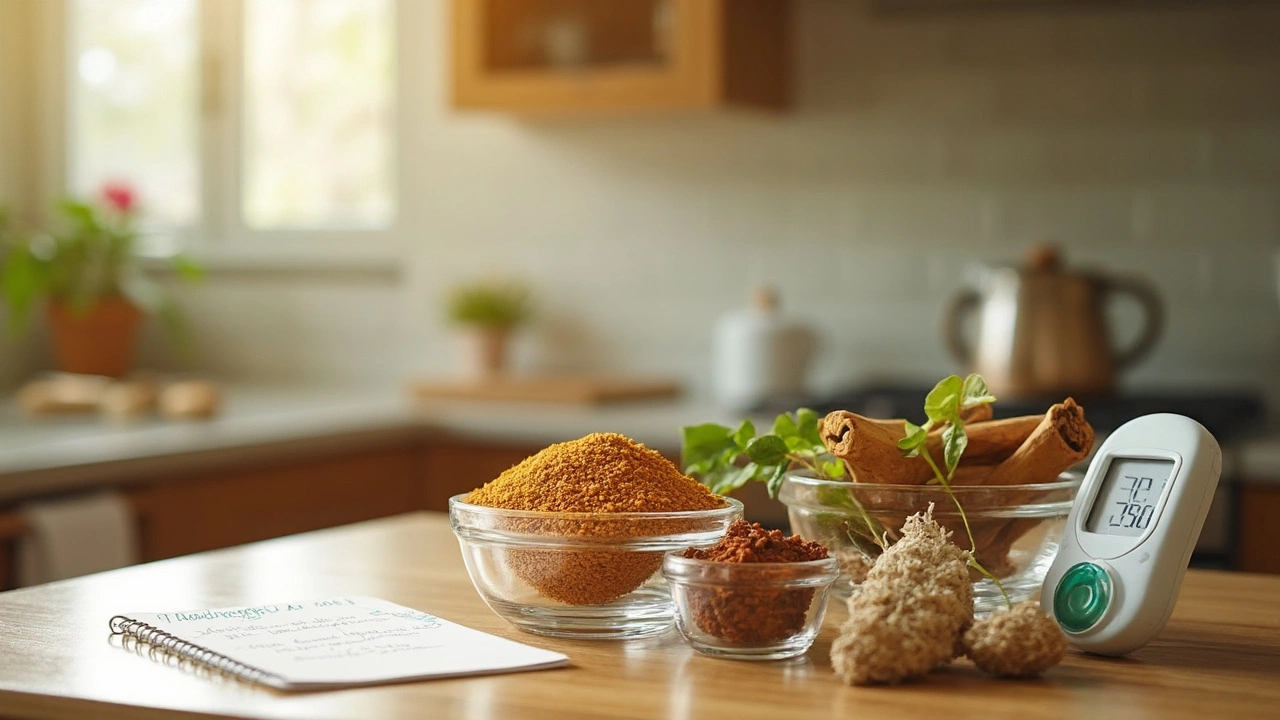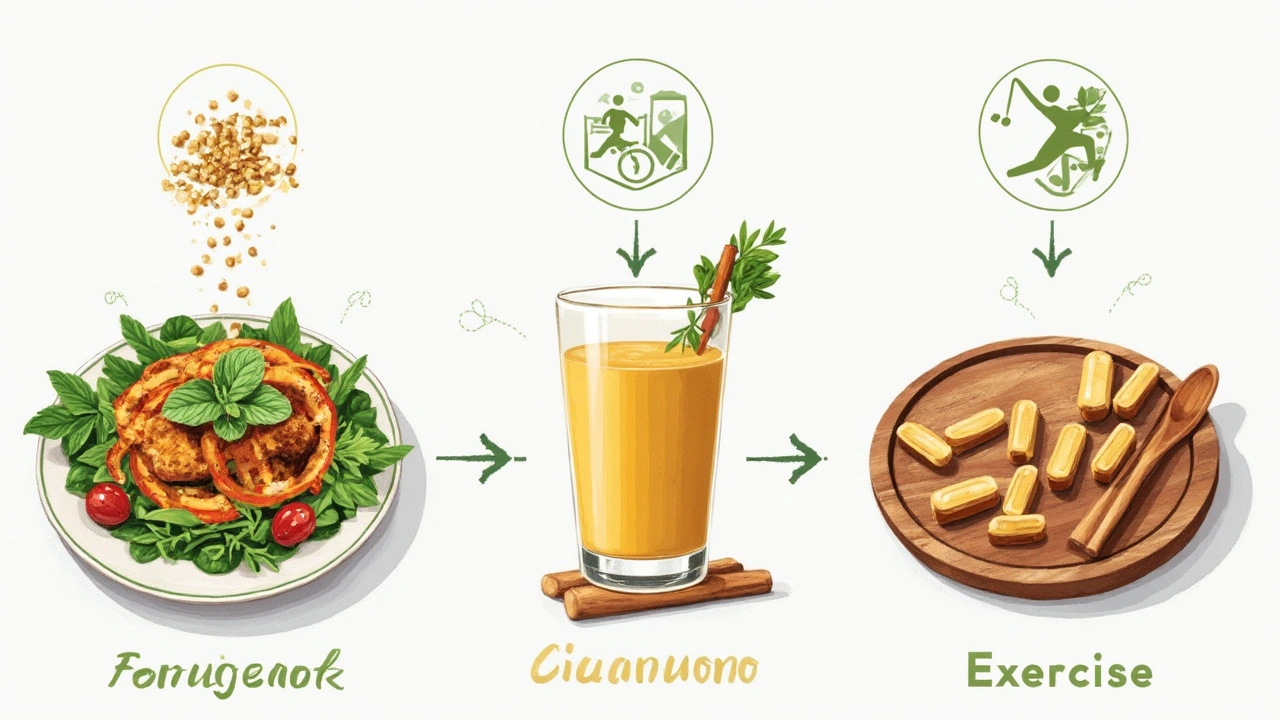Herbal Solutions for Insulin Resistance: Cinnamon, Fenugreek & Gymnema Backed by Science
 May, 3 2025
May, 3 2025
Cinnamon: The Delicious Spice with a Surprising Power Over Blood Sugar
Think of cinnamon, and you might picture sticky buns or spiced apple cider. Turns out this sweet-smelling kitchen staple does a whole lot more than boost flavor—science says it can help fight insulin resistance. Researchers first got curious when they noticed people eating meals with cinnamon had smaller spikes in blood sugar after eating. Sounds incredible, but it checks out: studies keep stacking up showing cinnamon can help the body use insulin more efficiently. What’s happening is that certain compounds in cinnamon help the muscles suck up more glucose out of the bloodstream. That means less sugar hanging around where it shouldn’t be.
One of the most famous studies, published in the journal Diabetes Care, looked at people with type 2 diabetes who took just 1 to 6 grams of cinnamon a day (way less than a teaspoon). In just 40 days their fasting blood sugar dropped by up to 29%. Researchers also saw improvements in cholesterol. Pretty amazing for something you sprinkle on yogurt. There are a few different types of cinnamon, but the kind that’s most studied for blood sugar is Cinnamomum cassia (or Chinese cinnamon). Cassia is usually the cheaper kind you find in supermarkets. Ceylon cinnamon is another variety—tastier and more subtle but a bit pricier on the shelf.
How does cinnamon work its magic? Its bioactive compounds appear to help insulin receptors become more sensitive, meaning your body needs less insulin to manage each meal. Cinnamon may also slow down how quickly your stomach empties, so carbs don’t hit your bloodstream in one giant wave. A handy bonus: it seems to block enzymes that break down carbs into sugar while you’re still digesting. This tag-team effect helps keep those sugar levels steadier for longer after eating. If you want to try it, experts say using up to 1–2 teaspoons (that’s about 2–4 grams) daily is safe for most people. Mix it into smoothies, oatmeal, Greek yogurt, or even warm milk at night. Just don’t try to swallow heaping spoonfuls on a dare (yes, the old cinnamon challenge is risky and absolutely not helpful for your health).
Some people do notice mild side effects like heartburn. A bigger concern is a compound called coumarin in cassia cinnamon. It’s safe in small amounts, but big daily doses over months could stress your liver. So, keeping cinnamon to culinary amounts or short supplement stints seems smart. If you take blood thinners or have liver concerns, double-check with your doctor. For most people, adding cinnamon to meals is a simple, low-fuss way to experiment with blood sugar support. The evidence is strong, and the taste is unbeatable. When you’re looking at alternatives to Metformin for type 2 diabetes, cinnamon pops up on almost every reputable list. It definitely earns its place in the kitchen and the herbal toolkit.
One more fun fact: in traditional medicine systems like Ayurveda and Traditional Chinese Medicine (TCM), cinnamon has always been a go-to for stabilizing blood, toning digestion, and fighting off “dampness” (which you could think of as sluggishness from too much sugar). Modern science just gives us new reasons to keep this old-school remedy on hand.
Fenugreek: The Unsung Hero for Blood Sugar Control
Fenugreek isn’t a household name, but it should be if you care about managing your insulin. This herb-turned-spice, often used in curries, has an earthy, nutty flavor that hints at something much more potent happening under the surface. Scientists started noticing fenugreek’s power when people taking it for other reasons started reporting fewer sugar crashes and easier weight management. What sets fenugreek apart? It’s all about the seeds. These little golden nuggets are stuffed with soluble fiber and special compounds, especially something called 4-hydroxyisoleucine, which directly boost insulin production. That means your pancreas gets a gentle nudge to make more insulin when you need it—without pushing it into overdrive.
Multiple clinical trials have tested fenugreek seeds in people with insulin resistance and early type 2 diabetes. A well-cited Indian study followed participants for three years, giving them 10 grams of ground fenugreek seeds daily (mixed into yogurt or water). The result? A whopping 40% decrease in the progression from “prediabetes” to full-blown type 2 diabetes. That’s not just a minor improvement—it’s a massive statistical drop. On top of that, people saw lower fasting blood sugar and better cholesterol. Some studies actually noticed a significant drop in blood sugar after meals, which makes fenugreek extra helpful if post-meal spikes are your main concern.
The magic here is fenugreek’s soluble fiber, which swells up in your gut and slows down the absorption of both glucose and carbs. This means meals digest more slowly and blood sugar rises are less dramatic. Some folks actually use fenugreek as a powder, mixed into warm water, before heavy meals. Be warned: the flavor is strong—think maple syrup mixed with celery! Some creative home cooks work it into soups and stews to mask the taste. Capsules are always an option for those who just can’t with the flavor.
Another thing to know: fenugreek can be super helpful for appetite control. That fiber fills you up fast. Some folks report feeling a little gassy or having tummy rumbles at first, but splitting the daily dose into two or three smaller servings helps. Just remember, if you’re pregnant, you should skip fenugreek, as it can trigger uterine contractions. People with peanut allergies should also be careful; fenugreek is part of the same plant family.
Fenugreek doesn’t just belong to South Asian dishes—adding it to pancake batter (really!), overnight oats, or tossing a teaspoon into chili can be an easy way to eat your way to steadier sugar. If you’re on the hunt for natural, affordable ways to tackle insulin resistance, fenugreek is probably sitting at your local grocery store, patiently waiting to shine.

Gymnema Sylvestre: The Sugar Destroyer Plants Wish They Could Be
Gymnema Sylvestre is a plant with a reputation that borders on mythical—its Hindi name actually means “sugar destroyer.” That’s not hype, that’s the effect. Chew a gymnema leaf and suddenly sweet foods taste like plain cardboard for hours. This weird trick has a very real purpose: less sugar craving, less sugar in your system, and a serious power-play against insulin resistance. Modern research not only backs up the cravings claim, but also shows gymnema promotes lower blood sugar and healthier insulin levels.
What’s behind this? Gymnemic acids, the plant’s star compounds, physically block the sugar receptors on your tongue and, more importantly, slow down sugar absorption in your gut. In other words, not only does food taste less sweet, but the sugar you do eat doesn’t all end up in your bloodstream. A randomized controlled trial from 2017 had prediabetic folks take gymnema capsules for 12 weeks. Results showed marked improvements in fasting blood glucose, A1C numbers (those telltale three-month blood sugar averages), and even big drops in sugar cravings—many participants naturally started putting less sugar in their tea or coffee without thinking about it. If that isn’t a win, I don’t know what is.
Gymnema stands out because it seems to support actual regrowth and repair in insulin-producing cells in the pancreas. This is huge. A lot of herbs are great for making your body use insulin better, but gymnema helps where insulin is made in the first place. Early animal studies (and some promising human data) say gymnema can help certain pancreatic cells pump out more insulin over time, not just temporarily.
So, what’s it like to take? Gymnema comes mainly as capsules (usually 400–600 mg, twice a day, with meals). There are also tea forms, though the taste is…an acquired one, let’s say. You can chew the dried leaves (for the full “sugar killer” effect), but only try that when you’re not headed into a birthday cake emergency—seriously, you won’t taste sweetness for hours! Most people experience zero side effects; a few get mild digestive upset at first. Like with all strong herbs, chat with your healthcare team if you’re taking any diabetes meds, as gymnema can magnify their action.
Some practical tips? Start gymnema days when you’re around home and can tune in to how you feel. It’s one of those “slow and steady” herbs: results build over a few weeks, not overnight. For those who dread sugar cravings when cutting carbs, gymnema is the friend you want. You’ll just notice one day you stopped missing dessert. That’s the power of blocking sugar at every turn.
Mixing and Matching: Do These Herbs Work Better Together?
If one herb is helpful, is a combo even better? Sometimes, yes. Cinnamon, fenugreek, and gymnema all have slightly different superpowers when it comes to insulin resistance. Cinnamon mostly helps your body stay sensitive to insulin and acts quickly after meals. Fenugreek works like a sponge, soaking up glucose in your gut and giving your pancreas a little motivation to crank up insulin. Gymnema does double duty by taming sweet cravings and helping the pancreas recover. When you put these together, you're hitting insulin resistance from every possible side—slowing down sugar absorption, boosting insulin, and dulling the siren call of sweets.
Here’s a fun fact from recent research: a 2021 study followed people with insulin resistance who used both cinnamon and fenugreek together in their diets for 12 weeks. The combo group had bigger drops in fasting blood glucose and reported better control over afternoon energy crashes—likely thanks to cinnamon keeping post-meal swings in check, while fenugreek slowed overall carb absorption. Gymnema, when taken alongside these two, actually helped people reduce how much sweet food they naturally wanted, leading to less temptation and easier weight loss over six months. Some supplement brands even offer all three in one capsule—just make sure the dose is similar to the ones studied.
Want to DIY your approach? Try starting with cinnamon at breakfast (mix it into your oats or smoothie bowl). Use fenugreek powder before lunch or dinner—half a teaspoon in plain yogurt or a warm drink will do it. And, if you get serious sugar cravings or eat out, gymnema before big meals can keep your sweet tooth under wraps. If you get any stomach upset (it happens!), cut doses in half and gradually work up. The biggest wins come when you’re consistent day to day, not just “all in” for a week.
Can herbs completely replace other diabetes meds? Not for everyone, especially if you have type 1 diabetes or more advanced type 2. But these strategies can make a real difference, especially if you’re using them with healthy meals and regular movement. Many people searching for alternatives to Metformin land on these herbs because they’re gentle, research-backed, and don’t usually come with harsh side effects.

Practical Tips for Trying Herbal Strategies
No one wants to add a dozen new rules to their life, so if you’re thinking about using cinnamon, fenugreek, or gymnema, keep it simple:
- Double-check quality: Always get your herbs from reputable brands, not just dusty bargain bottles online. Look for third-party testing or certifications and skip anything without clear ingredient labeling.
- Go for culinary doses first: Use cinnamon in your meals, fenugreek powder in soups or stews, and gymnema as a tea before you go all-in for capsules and concentrated supplements. Your body will thank you—and you’ll know quickly if your stomach agrees.
- Watch for side effects: No herb is magic, and they can sometimes cause tummy issues. Notice how you feel the first few days and adjust as needed. For most people, issues fade after a week or so.
- Stay in touch with your care team: If you’re taking diabetes medications or blood thinners, looping in your doctor is smart, as herbal helpers can amplify the effect (sometimes too much!).
- Give it time: Herbal improvements aren’t always instant. Stick with them for at least 6–8 weeks—and track your fasting glucose if you want proof of progress. Many folks see real shifts by the second month of steady use.
- Combine with smart basics: These herbs work so much better when you add gentle daily movement, regular meals, and plenty of fiber-rich veggies to your routine. Don’t skip water, either—herbal fiber can leave you thirsty!
If you’re a data lover or want to impress your doctor, keep a small journal of what you take each day—with notes on meals, movement, and how you feel. Patterns pop up faster than you’d think, and you might spot a perfect herbal timing formula for your unique metabolism. Here’s a tiny cheat sheet:
| Herb | Typical Dose | Best Timing | Main Benefit |
|---|---|---|---|
| Cinnamon | 1–2 tsp (2–4 g) | With meals | Reduces post-meal spikes |
| Fenugreek | 5–10 g seeds | Before heavy meals | Slows carb absorption & curbs appetite |
| Gymnema | 400–600 mg*2/day | 30 min before meals | Reduces sugar cravings, boosts insulin production |
Curious about how these compare to mainstream options? There’s a lot more to dig into about herbal alternatives to Metformin for type 2 diabetes if you want to see how other natural choices stack up. Compared to harsh drug side effects, these three herbs offer a gentle, science-backed way to nudge blood sugar and insulin resistance in a better direction.
The world of herbal insulin resistance help is growing fast as more solid research rolls in—and the best news is these strategies are easy to integrate into daily routines. Cinnamon, fenugreek, and gymnema have made the leap from traditional medicine straight into the toolbox of anyone wanting stable blood sugar and less drama after meals. Who knew the answer could be hiding in the spice rack?

angie leblanc
May 5, 2025 AT 05:55also i think the FDA is poisoning the cinnamon supply with glyphosate. i stopped buying it from walmart.
LaMaya Edmonds
May 6, 2025 AT 00:41And yes, fenugreek’s fiber content is legit - but only if you’re not eating 3 slices of toast with it. Synergy matters. Don’t turn your kitchen into a supplement lab without baseline metrics.
See Lo
May 7, 2025 AT 08:09Correlation ≠ causation. Also, coumarin in cassia cinnamon is hepatotoxic at >0.1 mg/kg/day. You’re consuming 10x that if you use 2 tsp daily.
Don’t confuse culinary use with therapeutic dosing. You’re risking liver damage while believing you’re ‘natural.’ This is pseudoscience dressed in cinnamon.
Chris Long
May 8, 2025 AT 14:05My grandpa didn’t know what fenugreek was - he lived to 92 chopping wood. You want stable blood sugar? Stop eating carbs. Move your body. Quit whining about ‘insulin resistance’ like it’s a medical condition and not a lifestyle failure.
Liv Loverso
May 9, 2025 AT 03:15Cinnamon is the poet of the spice rack - soft, seductive, whispering insulin receptors to open. Fenugreek? The stoic monk, fasting in the gut, slowing time itself. And gymnema - oh, gymnema - it’s the god of taste, stealing sweetness from your soul like a thief in the night.
You think you’re managing glucose. You’re actually dancing with ghosts of Ayurveda. And you don’t even know it.
Steve Davis
May 9, 2025 AT 07:30Also, I started telling everyone I met about this. My barista now asks if I want ‘the cinnamon miracle’ in my latte. I think I’ve become one of those people. Help.
Attila Abraham
May 10, 2025 AT 13:50my cousin took gymnema and got hypoglycemic at work had to eat a whole bag of skittles just to stay conscious
herbs are cute but don’t be stupid
Michelle Machisa
May 12, 2025 AT 10:50Don’t overcomplicate it. Add one thing. Stick with it. Let your body adjust. You don’t need a PhD to eat better.
Ronald Thibodeau
May 13, 2025 AT 06:34It’s fiber. It’s antioxidants. It’s not a secret.
Also, if you’re buying ‘third-party tested’ supplements, you’re literally paying for a sticker. Most of these are just ground-up plant matter.
Just eat the whole food. Ground fenugreek seeds are cheaper than capsules. Cinnamon from the grocery aisle is fine. Stop falling for the wellness industrial complex.
Shawn Jason
May 13, 2025 AT 17:03Now we call it ‘science’ when we rediscover what cultures have known for millennia. But we still treat it like a product to be optimized, not a relationship to be cultivated.
Maybe the real solution isn’t the herb - it’s the humility to listen to older wisdom instead of chasing the next supplement.
Monika Wasylewska
May 14, 2025 AT 01:49Maybe that’s the point - it works best when it’s not a ‘supplement’ but part of the rhythm of eating.
Jackie Burton
May 15, 2025 AT 04:41Also, the lead researcher got a patent on the cinnamon-fenugreek blend.
It’s not science. It’s a monetized myth wrapped in a PubMed abstract.
Philip Crider
May 17, 2025 AT 03:34It was like eating cardboard with cheese on it. No craving. No guilt. Just… silence.
My grandma in the Philippines used to say, ‘If it tastes weird, it’s healing you.’ She was right. 🌿✨
Diana Sabillon
May 18, 2025 AT 05:21I’m not saying herbs cured me. I’m saying they helped me heal - with my doctor’s help, not instead of it.